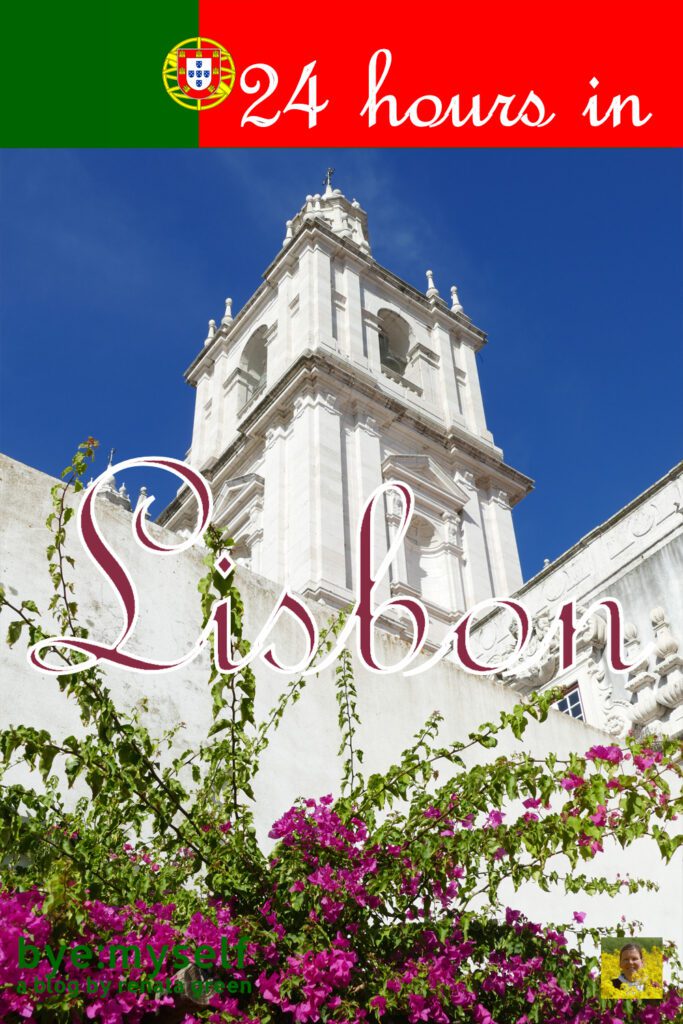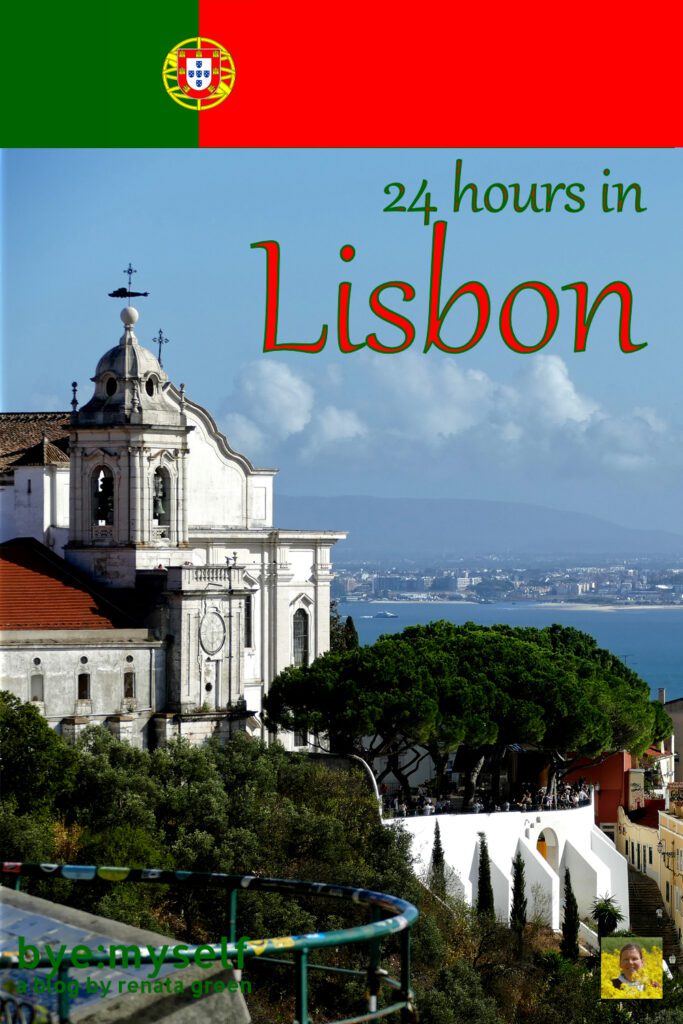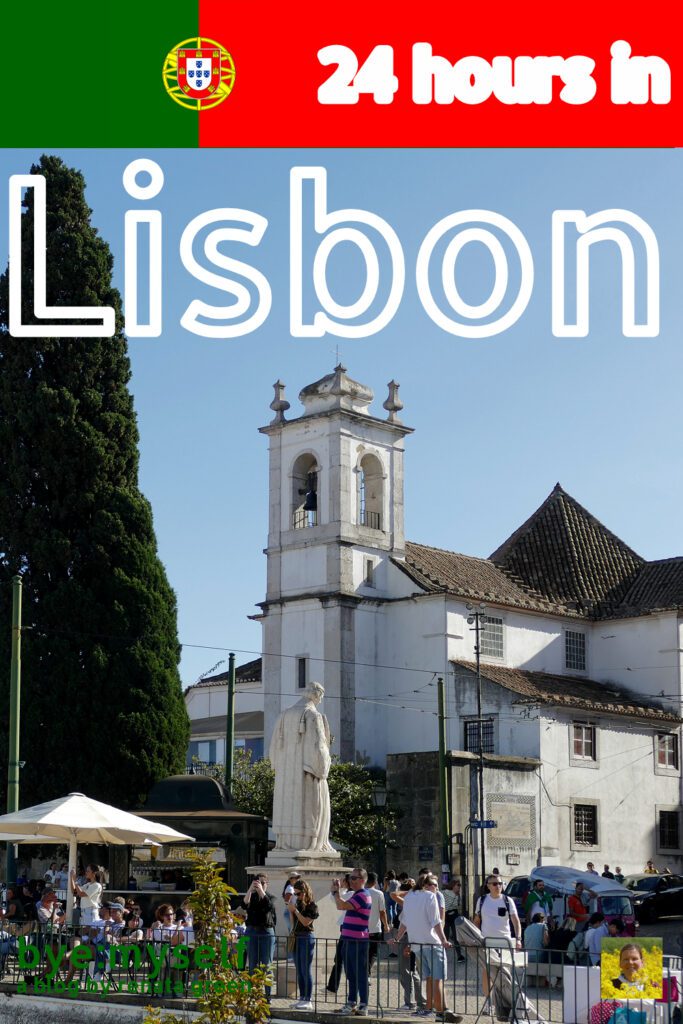This is a completely revised, updated, and expanded edition of one of my first 24 hours in… posts. This series was created because, like most travelers, I’m always on the hunt for the cheapest flights possible. The downside is that this often includes connecting flights and, especially on transatlantic flights, I have a longer stopover in a city. Instead of killing time at the airport in annoyance, I venture to the center and this way, enjoy an extra city break. Funnily enough, my first two visits to Lisbon were stopovers: once on the return flight from Miami and the second time on the outbound flight to Santiago, the capital of Cape Verde. This inspired me to summarize in a short guide what you can see and do in Lisbon in 24 hours.

By the way, I now deliberately postpone connecting flights to include short stays like this when my schedule allows it. Hence, I recently booked the flights on my flight to the Azores so that I could spend time in Porto on the outward flight and in Lisbon on the return flight.
I hope I can inspire you to make a virtue out of a supposed necessity.
Bem-vindo a Lisboa
Lisbon is one of the oldest cities in Europe and offers the perfect mix of history, culture, and modern urban life. It is located on seven hills, giving it a spectacular geographical position and unparalleled views of the sea and the Tagus River. The city is often referred to as the City of Light due to the special, warm light.

In recent years, Lisbon has become one of the most attractive tourist destinations in Europe. With its mild climate, historical sites, and vibrant atmosphere, the city attracts millions of visitors from all over the world every year. Historic districts such as Alfama and Mouraria, with their narrow, labyrinthine streets and traditional fado houses, contrast with the modern shopping centers and restaurants in the newly developed Parque das Nações district. By the way, UNESCO listed the melancholic musical style Fado as an Intangible Cultural Heritage of Humanity.
 Local Currency
Local Currency
Euro (EUR) / 1 EUR = 1.18 US$ as of September 2025 / current rate
 Emergency Contacts
Emergency Contacts
Police 112
(At this number, you also reach a service center that can redirect you to other help centers)
 National Airline
National Airline
 Airports
Airports
Lisbon Airport / IATA-Code: LIS
 Tourist Info Online and Onsite
Tourist Info Online and Onsite
Turismo de Lisboa Visitors & Convention Bureau
Rua do Arsenal, 21
1100-038 Lisboa
Phone: + 351 – 210 – 312 700
Email: atl@visitlisboa.com
 Getting Downtown and Back
Getting Downtown and Back
Unlike many other European capital cities, Lisbon has only one airport. Therefore, it is served by regular and low-cost airlines alike. The airport is located 7 short kilometers north of Lisbon’s center and is conveniently connected with the city by the subway line Vermelha, which translates to red. This metro takes you to the city center in 25 to 35 minutes, depending on your final destination, obviously. A single ticket costs as little as 1.80 €uros.

However, if you are planning on using public transportation the same day, you’d better get a 24-hour ticket for 6.80 €uros right at the airport. This ticket even includes the Santa Justa elevator, where just a single ride already sets you back 6 €uros, as well as the city’s legendary funiculars.
 Morning Activities
Morning Activities
I’d argue that Lisbon is clearly a perfect good-weather destination. You can spend entire days just walking around, strolling through narrow cobblestone alleys, and climbing scarily long stairs.
As a matter of fact, the city was built on seven hills, hence, one of its strongest suits is the spectacular views. You will find a high density of fantastic viewpoints over the city in the old Alfama district. Alfama stretches from the area around the Castelo de São Jorge to the banks of the Tagus. Many of Lisbon’s classic sights are located here.

So if you stay in the recommended hotel, you can stroll to Praça Martim Moniz in just a few minutes and from there take tram 12E to Largo Portas Sol.
Although the Miradouro das Portas do Sol is a tourist hotspot, it is one of my favorite places in the city. Even the crowds can’t diminish its beauty and charm.
The Portal to the Sun – the English translation of the name – fully lives up to its name. The viewpoint is on the south side of the castle hill and offers a wide view over the city’s red roofs all the way down to the river. To your left, you will spot the iconic Igreja e Mosteiro de São Vicente de Fora on yet another hill. If the sky is clear, you can even see as far as the Serra da Arrábida from this viewpoint!
Castelo de São Jorge
Once you can tear yourself away from these fantastic views, it’s time for the short but still sweaty climb to the Castelo de São Jorge.

The Moors built the castle but lost it to Alfonso the Conqueror in 1147. It was then used as a royal castle for centuries. In 1755, the castle was largely destroyed in the Lisbon earthquake. Today, the complex includes several towers, guard posts, a moat, excavations from the Phoenician, Roman, and Moorish period,s as well as two large squares where you can linger. You can stroll through the tranquil gardens filled with endemic plants, peacocks, and shaded benches before climbing the towers. You can also find the Camera Obscura, a periscope device offering real-time 360-degree views of the city. Inside the castle is also a small museum.
The general ticket, which grants access to all parts of the complex, costs 15 €uros. Depending on the time of year, the opening hours of the castle, archaeological site, museum, and camera obscura vary. Therefore, make sure to check their website before your visit.
 Morning Activities
Morning Activities
Even if it’s raining, there’s no better way to see the most alluring parts of the city on dry feet than a ride on the legendary #28 tram!
As a matter of fact, riding the #28, a vintage tram from the 1930s that is still part of Lisbon’s public transport network, has become one of the city’s most popular activities. No wonder, because the charming vehicle drives past some important sights.

Inaugurated in 1914, the route of the #28 stretches for 7 kilometers and connects Martim Moniz Square with the Campo de Ourique district. No car or bus can compete with the legendary tram when it comes to squeezing through the narrow streets and around the corners of the older neighborhoods!
To avoid the biggest crowds, it’s best to start your tour as early as possible. To have a better chance of getting a seat, board at the starting point in Martim Moniz.
Depending on traffic, the journey takes around an hour for the entire route.
The single ticket costs 3 €uros and can be purchased from the driver. On the other hand, a day pass that entitles you to unlimited rides on Lisbon’s entire net of public transport, sets you back only 6.60 €uros, hence, it’s easy to do the maths.
Because the #28 passes so many landmarks and iconic places, it’s tempting to get out every time you see something particularly attractive. In theory, this is correct, because if you have a day ticket, you only have to wait for the next tram to continue your journey. Due to the over-tourism that Lisbon in particular suffers from, I advise against using #28 for a sightseeing tour. The vehicles are always full, and there are often long queues at the stops.
The Grand Tour
For a hop-on hop-off tour, it’s better to take the official sightseeing tram.

It follows the same route, and you can always find a seat. The trip costs 25 euros, but your ticket is valid for 24 hours and includes free access to the Santa Justa elevator and the Bica, Glória, and Lavra funiculars. You can also use an audio guide in several languages. Funnily enough, you can also use your ticket to travel on the regular #28, in case you want to rub shoulders with locals fellow tourists.
You can pre-order your ticket here* to avoid the queue.
Riding the tram – whether the red hop-on hop-off tram or the “real” yellow one – allows you to see a lot of the city despite the bad weather, obviously. Additionally, you can get off at places that particularly interest you.

If you set off from Praça Martim Moniz, the first stop could be the Igreja de São Vicente de Fora. If the weather permits, a short stop at Largo Portas Sol is highly recommended for some amazing views, albeit, in the rain, they might be a bit moody.
You can also squeeze in a visit to the Sé, Lisbon’s Cathedral, and of course, stop at the Elevador da Bica in the Chiado district. Here you can take the iconic funicular down and back up again for as little as 4.10 €uros a round trip.
 Lunch
Lunch
The journey of the 28E begins and ends at Praca Martim Moniz in the Intendente neighborhood. It is a historic district that was once known for its bohemian lifestyle. Located at the western foot of the Colina de São Jorge, it can be reached in a short descent from the Castelo.

In recent years, Intendente has been through a massive transformation. Shops and restaurants from India, Nepal, and Pakistan dominate, especially in the side streets. So if you don’t necessarily want to try the local cuisine, you will find an endless selection of Asian dishes here.
However, if you prefer to eat traditional Portuguese food, I recommend the restaurant Zé da Mouraria, where you can indulge in bacalhao and other specialties.
 Afternoon Activities
Afternoon Activities
After lunch, it’s time to explore another fascinating part of Lisbon, namely the Chiado district. You can stroll from the Praça Martim Moniz to Praça de Dom Pedro IV, better known as Rossio.

The best way to continue from there to the Chiado neighborhood is to take a ride on the world-famous Elevador de Santa Justa.
Nevertheless, since there are almost always long queues, it’s definitely faster to walk along the Rua do Carmo located behind the Elevador. It leads on a gentle slope into the heart of the district.
There are some amazing attractions in Chiado. First of all, of course, the famous Elevador da Bica. A visit to Lisbon is not complete without having seen this funicular.

However, you can also join a free walking tour at the Praça de Luís de Camões. But don’t forget that the guides live off tips. Hence, try to be as generous as possible.
 Afternoon Activities
Afternoon Activities
One of the best ways to spend a rainy afternoon in Lisbon is by visiting a museum, obviously. Incredibly, one of my favorite galleries is relatively unknown, at least among tourists. The Calouste Gulbenkian Museum is even housed in an award-winning building!

As a matter of fact, the museum consists of two parts. One is the private collection of Calouste Gulbenkian, a businessman born in Constantinople, hence, today’s Istanbul, in 1869. When he died in Lisbon in 1955, he left an amazing fortune.
The museum’s permanent exhibition reflects the founder’s diverse art interests and includes a wide selection of art from all eras. It is organized chronologically and geographically.
The exhibition begins with art from antiquity. European book art, as well as European painting and sculpture since the 15th century, is also on display.
Separate rooms are dedicated to the works of Francesco Guardi and René Lalique.

In addition, the Centro de Arte Moderna Gulbenkian CAM is an important venue for contemporary art. It has one of the largest collections of modern and contemporary Portuguese works of art. On the occasion of its 40th anniversary, the building was renovated and redesigned by Japanese star architect Kengo Kuma.
The museum is open Wednesday to Monday from 10 a.m. to 6 p.m. General admission tickets for both venues cost 14 €uros, and an all-inclusive ticket also including all special exhibitions costs 16 €uros. You can purchase tickets in the museum or in advance online.
 Dinner
Dinner
Calling this culinary institution from 1956 a Cervejaria, hence, a beer house, is a huge understatement! Ramiro is one of the best eateries in the city, and anyone who loves seafood has come to the right place. Crabs, shrimps, mussels of top quality, and, for what it is, at reasonable prices.
However, make sure to book a table to avoid disappointment since Ramiro is far from being a hidden gem.
 Nightcap
Nightcap
Since the highly recommended Hotel 1908* is right across the street from Ramiro, I wouldn’t venture out for a drink but enjoy a nightcap at the stylish hotel bar.
 Accommodation
Accommodation
One of the best hotels for a short 24 hours-break is definitely the Hotel 1908*. Named after the year it opened, it is a stunning mix of historic charm and modern design. Hotel 1908* is housed in a beautifully restored Art Nouveau building and combines architectural elegance with modern comfort. Its strongest suit for a stopover in Lisbon is its very convenient location in the Intendente district. From here, the metro takes you to the airport in just around half an hour for as little as 1.80 €uros.
Understandably, not everyone will have the opportunity to splurge. Therefore, on this map, you can choose suitable lodging options in Lisbon according to your individual budget*:
Map
This map should help you to easily find all the wonderful places I’m introducing in this post. To switch between the itineraries for a sunny and a rainy day, just open the legend at the left upper corner, and you can hide or unhide the respective layer as you wish. This way, the map will show only the section you really need and be clearer.
If you have more time to spare in Lisbon, make sure to check out my comprehensive post Best of LISBON – also for solo-travellers. There you’ll find lots of places and activities to choose from.
Pinnable Pictures
If you choose to pin this post, please use this picture:






Note: I’m completing, editing, and updating this post regularly – last in September 2025.
Did You Enjoy This Post? Then You Might Also Like These:
What Not to Miss in TERCEIRA, the Azore Island of History and Grace
Best Things to Do in SAO MIGUEL, the Most Varied Island of the Azores
A Day in Sophisticated ESTORIL and CASCAIS
SAO JORGE – the Best Viewpoints of the Azores
Best Street Art in LISBON – Part I: Graça And Beyond
FAIAL – the Most Beautiful Island of the Azores
24 hours in PORTO
Best Street Art in LISBON – Part III: Moscavide
* This is an affiliate link. Hence, If you book through this page, not only do you get the best deal. I also get a small commission that helps me run this blog. Thank you so much for supporting me!
Icons: money bag by Roundicons from www.flaticon.com, police car, train, sun, glass, and bed by Freepik from www.flaticon.com, takeoff plane and board made by ultimatearm from www.flaticon.com, info made by Roundicons from www.flaticon.com, umbrella made by Kiranshastry from www.flaticon.com, food plate by Vectors Market from www.flaticon.com
 National Airline
National Airline Airports
Airports Tourist Info Online and Onsite
Tourist Info Online and Onsite Getting Downtown and Back
Getting Downtown and Back







Just wish to say your article is as astounding. The clearness of the structure is simply cool and so helpfull! Well along with your permission let me to grab your RSS feed to stay up to date with forthcoming post. Thank you one million and please carry on the rewarding work.
Thank your for your kind words. Yes, my 24 hours series is quite popular. Glad you like it, too 🙂
Hi! I just want to give you a big thumbs up for the excellent itinerary you have here on a short stay in Lisbon.
I will also check out the extended version.
Either way: Obrigada!
Glad I can help! Also, there will be an updated version soon 😉